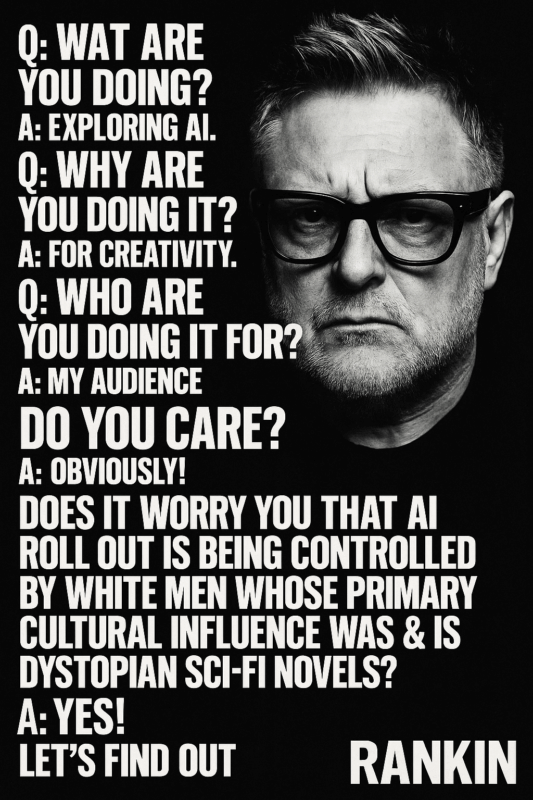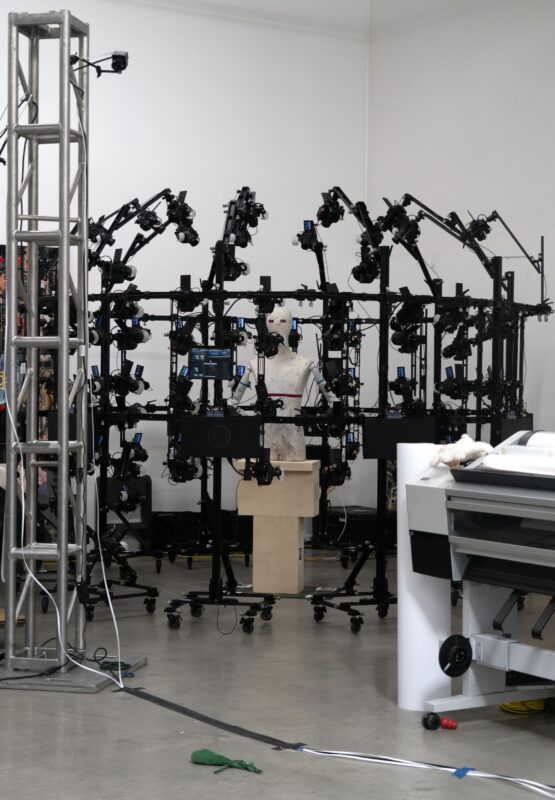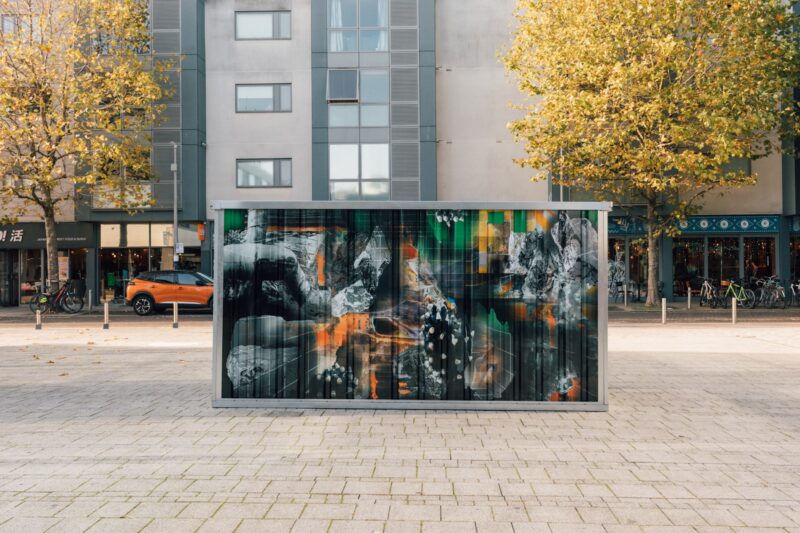
Artificial Intelligence of Virtual Reality is a survey of Uli Ap’s site-specific immersive installations disorienting the visitor in a cross-reality zone between virtual, physical, and mental realms. Selected installations deal with issues of sacred and transitional spaces that generate sound through immediate interaction. Enveloped by soundscapes of Sacred Danger and That Side Where Real Is, you enter the altar of Anti-Gravity Reality: Inside the Black Cube or Brain AI transporting you into a transdisciplinary encounter between Virtual Reality, Artificial Intelligence, Robotics, and Neuroscience. There, you donate your emotions to a machine. Sounds at interventions to provoke your anxiety are the ones of Sacred Danger and That Side Where Real Is. All installations are connected. And standing in the middle of the ineradicably vast space of Ambika P3 you hear them merging with a sound of your heartbeat.
Installations:
Anti-Gravity Reality: Inside the Black Cube or Brain AI [prototype]
Sacred Danger [Part II] [the Kim Fielding Award for experimental arts]
That Side Where Real Is [Crypt@St.Mark’s St Mark’s Church Kennington]
Red Film & The cReature Film
ANTI-GRAVITY REALITY: INSIDE THE BLACK CUBE OR BRAIN AI is an interactive cross-
reality installation that collides Virtual (VR), Physical, and Mental Realities.
Human emotions and feelings are being consumed by a living AI organism in order to create itself in both virtual and physical realms. The system measures your anxiety level and feeds itself with it through biofeedback sensors. Biosignals from electroencephalogram (EEG), galvanic skin response (GSR), and pulse sensor manipulate the environment. Virtual Reality acquires Physical qualities and tactile sensations. The experience is totally disorienting. Interacting with structures produced by their own brain, a participant unknowingly becomes a performer. Each experience will be unique and the space constructed at its culmination will be catalogued and transformed into an outside anti-gravitational pavilion. Recorded, it will travel to a gallery again as 360 VR installation.
The project merges art, science, and technology and stands for erasing labels, identities, disciplines, and geographical borders by advocating freedom of choice and movement. At no given moment, a participant is sure whether they are still in virtual or already in physical space. Or might be somewhere in space of their own imagination. It is a transdisciplinary encounter between Virtual Reality, Artificial Intelligence, Neuroscience, and Robotics.
SACRED DANGER [the Kim Fielding Award for experimental arts]
Part I: outside installation Part II: multi-channel sound-video installation transferring experience of a physically built space through the digital realms
Sacred Danger – immersive site-specific outside installation or a structural intervention in a landscape reinventing a sacred space. A project is inspired by my research trip to Blaenau Ffesteniog in North Wales, where I have been taken by local people to abandoned slate queries. By experiencing a sensation of the innermost fear and danger during this journey – those slate queries could collapse any time – I have compared them to Gothic cathedrals, that one of a beauty and attractive seduction though simultaneously the one of a danger and manipulation.
Visible from far away fields, Sacred Danger sits on a sharply inclined hill like a weightless cloud inviting you to enter into its inside. Although, the very moment you find yourself there, a situation is reversed into insecurity and vulnerability by exposing your body to the attack of a fluctuating under the strong wind structure built out of just 6mm plexiglass penetrated by massive 1inch steel rods. Dragon shape of a zig-zag foundation is confusing in its refractive magnifying reflections, and willing to escape to a stunning sea side horizon you are bounded to a disappointment – you are inside the space with no exit. The exit is blocked by a transparent plexiglass which obviously you do not see unless by touching it on approaching. In effect, you would try to exit Sacred Danger on every turn of a dragon only to realise that transparency is an illusion and all your senses and perceptions are disoriented. Chameleonic nature of Sacred Danger, with a great sensitivity reacting on each of the atmospheric conditions, makes the
structure change its appearance within nearly every hour. Transparent throughout the day. Frosted in the early morning by dense fog. Turning flaming red in the sunset. With sliding raindrops in the evening. The structure claims its own presence to be unbelievable. A space with no exit dissolves in nature by confronting it. Triggers the mind by challenging and provoking it. Delusional crystal clear transparency of plexiglass transforms Sacred Danger into a totally invisible volume suspending threaded bars in the air. It is deliberately created to transfer the feeling of insecurity, instability and danger – you just simply don’t believe that the structure holds itself up – and this is exactly how it should be. Though, each experience would be totally different, somehow you are supposed to be scared inside – and so you do.
On entering Sacred Danger through a hole in a bush, you are signing an agreement with nature by excepting a possibility of the existence of something that logically could not have ever existed.
THAT SIDE WHERE REAL IS
9 site-specific immersive Installations challenging our perceptions of reality Crypt@St.Mark’s Kennington, London, UK [TSWRI] Nine Site-Specific Immersive Installations Questioning Perceptions of Material Reality
& Dream-Like States of Consciousness
Components of ‘That Side Where Real Is’:
Cracking incorporating The cReature film [Room1]
Transparent Invisibility [Room2]
Suspended Dreams to Eat the Time [Room3]
There Is No One In Here [Room4]
Vertical Immersion [Room5]
All How It Was [Open Room]
Black Penetration Into And Through Horizontal Dimensions [Corridor. Part I]
Black Penetration Into And Through Horizontal Dimensions [Corridor. Part II]
Red Gloss One String [Entry Hall]
Multi-component installation ‘That Side Where Real Is’ – is a series of physically constructed, site-specific, inter-connected installations challenging our perception of space and the idea of the space as such built from ephemeral materials or materials that become ephemeral when being constructed into the space. To go through the installation is mentally, intellectually and emotionally intense experience activated by constantly changing hallucinational spaces on the way you move. At the installation context, a body becomes a tool penetrating a space [human element penetration] confronting a built environment battling with the dissolution and vagueness.
The exhibition’s title, ‘That Side Where Real Is’ refers both to the visual challenges conveyed through the materials used and the way they trick the mind by disorienting the body, making it to squeeze in-between something that seems to be impossible to enter, perceive something that human eyes cannot simply see unless they are positioned at certain angles or fixed at the points of the space where the light is reflected. Emotionally and intellectually challenging chameleonic geometry that constantly changes into hallucinational spaces while your body is moving. It is a division between physical and abstract, rational and intuitive – with a big question mark on which of them is real.
A peculiarity of the site is echoed in here – being in an underground crypt, empty and dark, with the whole universe of life happening on the upper layer inside the building of the church itself; and, then, beyond the point of the church – in a real life on the streets. Due to the very nature of the crypt ‘That Side Where Real Is’ deals with a notion of a death/life duality. Sound at the installation is derived from the material elements themselves – be it cracking dry leaves or transparent fishing wire strings, or black elastic shock cords. By reacting on a bodily movement, singular elements generate noises as a response. Those noises are important part of the perception. ‘That Side Where Real Is’ continues to experiment with light, its effect on visibility and depth, and a coloured light as a separate material. The cReature film is as process-based as the overall construction and being organically buried inside dry cracking leaves narratively tells a birth-life-death sequence with the absolute awareness of its senselessness. Being divided on two sides a real has a character of a vague and obscure presence that is constantly transferred in-between. A space of the film prolongs disorienting irony of transparent and invisible strings, deepening it down towards the very extremes.
Uli Ap Artificial Intelligence of Virtual Reality Ambika P3 University of Westminster
35 Marylebone Road London NW1 5LS [entrance through the main reception]
About The Artist
Uli Ap is a trans-disciplinary artist researching into a cross-reality zone between virtual, physical and mental spaces where definitions between the mediums and disciplines are no longer possible. Provocatively colliding art, science, technology, architecture, and journalism, the artist creates intellectually challenging and bodily disorienting site-specific immersive interactive installations to question our perceptions of the self and various levels of reality.
Uli lives and works in London and travels the world extensively to exhibit and take part in art residencies. Ap undertook artist’s residencies in the British School at Rome, ‘International
Artist-in-Residence’ in Aso, Minamioguni-machi, Japan, received inaugural Kim Fielding Award for experimental arts, Cardiff, Wales and Emerging Artists Promotions Grant, London, UK. Ambika P3 exhibition gives a comprehensive insight into the artist’s practice. Uli Ap’s work is included at the forthcoming “Weather the Weather” a SciArt Initiative exhibition at the New York Hall of Science.
Ambika P3 is a 14,000 square ft space developed from the vast former concrete construction hall for the University of Westminster’s School of Engineering. Built in the 1960s, it is a distinctive space for contemporary art and architecture which presents a public programme of solo and group exhibitions, education projects and talks and events involving the academic community from the Faculty of Architecture and Built Environment and Westminster School ofMedia, Arts and Design.







